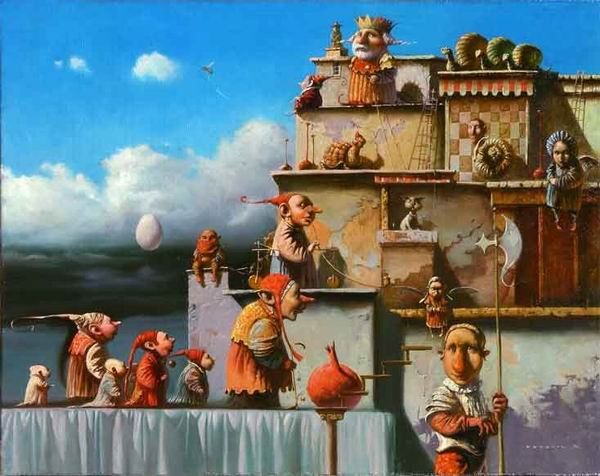
To Be a Good Tactician Learn How to... SHAPE Your Opponent!
“Chess is war over the board. The object is to crush the opponent’s mind.” — Bobby Fischer
To win this war you need to impose your will on the opponent. You need to shape the opponent’s mind and actions on the board to your advantage. How do you overcome the friction that always exists in a conflict? By using force and all the tactical weapons to bring the opponent in on your terms.
 Shaping the opponent
Shaping the opponent
But tactics doesn’t come by itself. You need to prepare the battlefield and shape your opponent before the actual encounter arrives. You need to influence events leading to the decisive battle with an effective strategy. Battles are won before they actually begin.
First You-the-Strategist identify the enemy’s critical vulnerabilities or induce weaknesses in his position yourself. Once your advantages have accumulated, everything is set up for a violent tactical denouement. You-the-Tactician is then able to deliver that crushing final blow to them.
The shaping is a proactive approach using initiative to impose your game on the opponent. It constitutes:
- Aggressive play
- Fighting the enemy's strategy
By shaping the opponent you make him conform to your desires and actions. At the same time, you take control of the situation away from them and narrow their options down.
Here is a short game played by the great Akiba Rubinstein where we can clearly see the concept in action:
Rubinstein – Hirschbein, Lodz, Poland, 1927
1.d4 Nf6 2.c4 e6 3.Nc3 d5 4.Bg5 Be7 5.e3 O-O 6.Nf3 Nbd7 7.Rc1 c6 8.Qc2 Re8 9.a3 h6 10.Bf4 dxc4
 Rubinstein-Hirschbein, Lodz, 1927 (after 10…dxc4)
Rubinstein-Hirschbein, Lodz, 1927 (after 10…dxc4)
Black decides to release tension in the center. He initiates the trade of dark-squared bishops. This is actually unfortunate as he inflicts his own wounds by weakening the dark square complex. While it is not decisive yet, this gives Rubinstein an opportunity to artfully increase this small advantage to something more tangible by use of “shaping.” The chess war is a process of mutual adaptation. One is able to win the victory only by constantly adapting and modifying his strategy and tactics in accordance with what the opponent is doing. You are not the more important party in the war you are waging. It is your opponent!
 A photo of our protagonists, Rubinstein and Hirschbein couldn't be found; instead, Rubinstein and Tartakower from the same 2nd Polish ch, Lodz 1927
A photo of our protagonists, Rubinstein and Hirschbein couldn't be found; instead, Rubinstein and Tartakower from the same 2nd Polish ch, Lodz 1927
Rubinstein spotted the weakness in the Black’s camp and is shaping his action in the desired direction.
11.Bxc4 Nb6 12.Ba2 Bd6 13.Bxd6 Qxd6 14.O-O Nbd7
Two tempi were wasted to carry out an unfortunate exchange. Meanwhile, the White’s bishop made a useful move to a2 from where it will help shape the opponent (18.Bb1). With the text Black hopes for a counter operation in the center (e6-e5) to free his game.
 Rubinstein-Hirschbein (after 14….Nbd7)
Rubinstein-Hirschbein (after 14….Nbd7)
15.Rfd1
Shaping! White actively opposes the Black’s intentions: “Fight the opponent’s strategy,” — Sun Tzu
15…Qe7 16.Ne5
White uses his knight to stop the advancement of the black e-pawn and is even ready for material concessions (19…Nxe5) for strategic advantage.
16…Nxe5 17.dxe5 Ng4
 Rubinstein-Hirschbein (after 17…Ng4)
Rubinstein-Hirschbein (after 17…Ng4)
18.Bb1
Shaping in its best! Given the opportunity White inflicts further weakening of dark squares in the Black’s camp with a deep wound at f6 in particular. The upcoming sac of the White’s e-pawn actually helps open the big diagonal to make the finishing tactical strike possible. The attacker always wants strategic roads open for use by their army.
As you can see, nothing comes without shaping the enemy. Battles are won before they even begin! You need to prepare the battleground first.
18…g6 19.Ne4
Now we see another dark side of the Black’s 10…dxc4. The white knight is now using the e4-square as a spring board to enter the fray. In the position Black resigns few moves later, it is the cooperation of White’s queen and knight to make it happen.
19…Nxe5 20.Qc3 Nd7
 Rubinstein-Hirschbein (after 20…Nd7)
Rubinstein-Hirschbein (after 20…Nd7)
Everything is now set up for the crushing tactical finish. White has so shaped the conditions of the battle that the result is now just a matter of course.
21.Rxd7
Removing the defender. White gains the key control over the f6-square that his knight will now make use of.
21…Bxd7 22.Nf6+ Kf8 23.Nd5
The double attack: the queen is threatening to checkmate while the knight is attacking the black queen and at the same time controlling the exit square for the king.
Black king resigns 1-0
You need to learn how to shape your opponent in every game you play. By always orienting on the enemy as it is fundamental to all warfare:
“As water shapes its flow in accordance with the ground, so an army manages its victory in accordance with the situation of the enemy.” — Sun Tzu
This was a RoaringPawn's guest post published on NM William Stewart's site (now www.iChess.net) on June 23, 2012 as one in a series of articles for Beginners.
.
